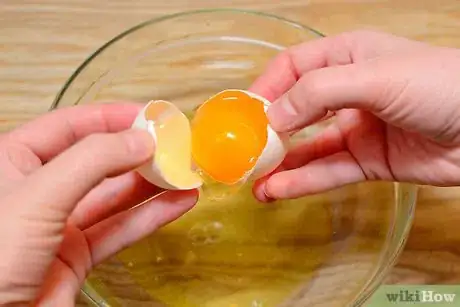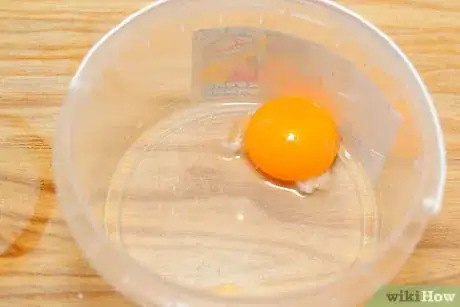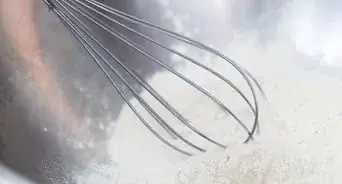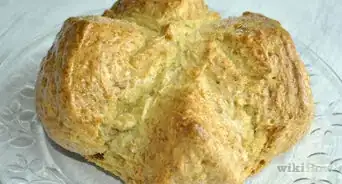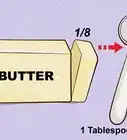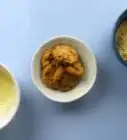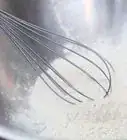X
This article was co-authored by wikiHow Staff. Our trained team of editors and researchers validate articles for accuracy and comprehensiveness. wikiHow's Content Management Team carefully monitors the work from our editorial staff to ensure that each article is backed by trusted research and meets our high quality standards.
This article has been viewed 127,560 times.
Learn more...
Meringue is a light, low-fat mixture of whipped egg whites and sugar that is used to top pies or make cookies. To achieve a thick and glossy texture, attention must be paid to the details: the quality of the eggs, the time you spend beating the whites, and the temperature of the oven. Read on to learn how to make meringue.
Steps
Method 1
Method 1 of 3:
Making Thick and Glossy Meringue
-
1Separate the eggs. Using the freshest eggs possible, carefully separate the whites from the yolks over a clean, dry mixing bowl. Crack the shell, separate the halves, and pour the yolk gently from one shell half to the other as the white drops into the bowl. Repeat with as many eggs as your recipe calls for (usually 2 or 3 for a typically pie topping).
- Reserve the yolks for later use in custard or ice cream.
- Use a different egg separating technique if you prefer not to use the shell transfer method.
-
2Let the egg whites sit at room temperature for 30 minutes. The temperature of the eggs greatly affects the texture of the finished meringue, so it's important to allow time for them to come to room temperature. Make sure the bowl isn't too close to a hot oven or a cool spot.Advertisement
-
3Beat the egg whites with cream of tartar. This binding substance helps the egg whites form into thick, glossy peaks. Most recipes call for about 1/2 teaspoon of cream of tartar for 2 egg whites. Beat the egg whites and cream of tartar with a hand mixer until the mixture is white and foamy with soft peaks.
-
4Add sugar and continue beating. The sugar should be added slowly with one hand as you continue beating the meringue with the other hand using a hand mixer. You'll typically need 1/4 cup sugar for every 2 egg whites. Continue beating until stiff peaks begin to form. The mixture will take on a glossy, satin sheen as you add the sugar.
-
5Test the peaks. Lift the hand mixer from the bowl of meringue. When you remove the beaters, stiff, thick, glossy peaks should rise and stay in place. When you tilt the bowl, the mixture should remain in place, rather than sliding forward. This means the meringue is ready to be used in a recipe.
Advertisement
Method 2
Method 2 of 3:
Knowing What Pitfalls to Avoid
-
1Make sure the mixture is at room temperature before beating. If it's too warm or cold, you won't be able to create the stiff, glossy peaks you need to make a good meringue.
-
2Avoid mixing yolk or shell with the egg whites. One little splatter of yolk will prevent you from achieving good volume and high peaks. The heavy yolk changes the composition of the mixture, as do bits of shell.
- If you drop some yolk or shell into the meringue, it's best to start over rather than trying to fish it out.
- You can avoid getting shell in the whites by cracking the eggs over a bowl different from the one you use to mix up the meringue, then transferring the whites carefully to the mixing bowl.
-
3Avoid getting water in the bowl. Make sure the mixing bowl you start with is completely clean and dry. During the mixing process, avoid getting even the merest drop of water in the bowl, as it throws off the composition of the meringue and ruins the dish.
-
4Don't pour in the sugar all at once. To achieve stiff, glossy peaks, you need to add the sugar slowly to give it time to mix in thoroughly and evenly.
Advertisement
Method 3
Method 3 of 3:
Using Meringue in Recipes
-
1Use meringue as a pie topping. This popular use of meringue requires a bit less finesse than you need to make cookies, since baking the pie with slightly softer peaks will still turn out beautifully. When your pie filling is prepared, simply spread the meringue across the top, then place it in the oven and bake it until the top of the meringue is light brown at the tips.
- You can make the pie look more decorative by creating mini peaks and curls. After you spread the meringue on the pie surface, use the back of a spoon to lightly touch the surface of the meringue and lift it into a small peak. Repeat in the pattern on the rest of the pie.
- Be sure that your oven temperature isn't too hot when you're baking meringue pie. In order for the peaks to hold, the moisture needs to evaporate gradually with relatively low heat.
-
2Make meringue cookies. To make cookies, be sure your batch of meringue has been beaten long enough to form quite thick, stiff, glossy peaks. Spoon dollops of the meringue onto a cookie sheet. Use the back of the spoon to lightly press the center of a cookie, then lift up to form a small peak. Repeat with the remaining cookies and bake them for about 10 minutes, or until they turn golden brown.
- You can flavor meringue cookies by stirring in cinnamon, pumpkin spice, small chocolate chips, or cocoa powder.
- For prettier cookies, fill an icing bag with meringue and pipe them onto the cookie sheet through a decorate tip. This way you can make ridged swirls and other patterns.
- To make peppermint meringues, mix a few drops of peppermint extract and red food coloring in a bowl. After piping the meringue onto the cookie sheet, use a small clean paintbrush to pain candy cane-like stripes around the ridges of the cookies before baking them.
-
3Finished.
Advertisement
Community Q&A
-
QuestionWhy do I need to put cream of tartar in meringue?
 Community AnswerThe cream of tarter helps the meringue keep its shape and stops it from running.
Community AnswerThe cream of tarter helps the meringue keep its shape and stops it from running. -
QuestionI got a drop of yolk in my whites, and now it won't get stiff. What do I do?
 Sofia C.Community AnswerYolk in the whites will prevent them from becoming stiff. Unfortunately, if you can't remove all the yolk, you will have to restart.
Sofia C.Community AnswerYolk in the whites will prevent them from becoming stiff. Unfortunately, if you can't remove all the yolk, you will have to restart. -
QuestionHow can I make more meringue?
 Community AnswerAdd more egg whites, and spend a little bit more time whipping than you would expect.
Community AnswerAdd more egg whites, and spend a little bit more time whipping than you would expect.
Advertisement
Things You'll Need
- Electric mixer
- Recipe for meringue
About This Article
Advertisement
